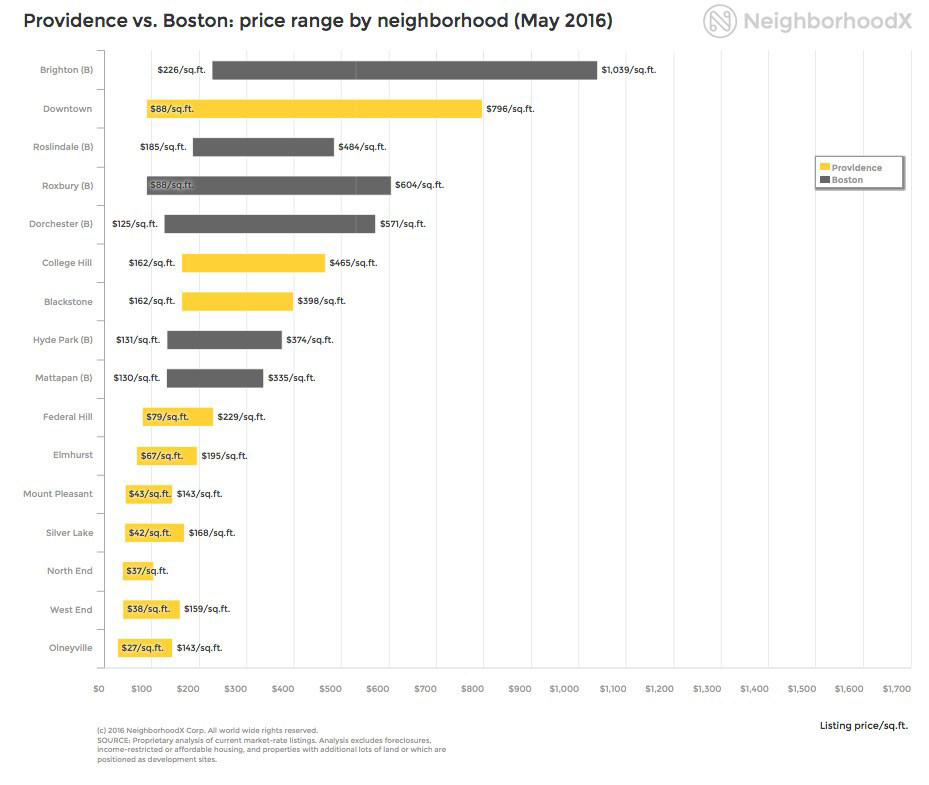Does Providence Boast Greener Pastures?

College Hill, Providence Photo by Will Hart on Flickr/Creative Commons
There’s a subset of Bostonians out there who’ve realized something: it might not be worth it dedicate a huge chunk of your paycheck to keep a roof over your head.
As exorbitant housing costs in the city continue to increase, renters and buyers alike are considering taking a one-way ticket out of here. A reasonable option? Our neighbor to the south—Rhode Island.
Morgan Hollenbeck is a real estate agent with Coleman Realtors in Barrington, Rhode Island. She says she’s noticed an influx of former Boston residents settling down in Barrington, a suburb south of Providence.
“It seems like it’s more young families who might have lived in Boston and then perhaps got priced out of it because they were renting and the prospect of buying something was just too much,” she says.
Plus, she adds, Barrington has a reputable school system.
“I think for people who are looking for strong schools at a slightly lower price point than Boston suburbs, this kind of becomes a place on their radar map of where to potentially look for homes,” says Hollenbeck.
While some transplants are getting new jobs in Providence, she says many continue to work in Boston. Hollenbeck notes the rise of telecommuting, making a daily trek to the city unnecessary in some cases. In turn, braving I-95 or the commuter rail for an hour both ways might not seem so daunting if it’s only two or three days a week.
That is precisely what Ryan Kowal does. The 30-year-old financial operations associate moved from Boston to Providence with his wife in September. He commutes to UMass Boston twice a week while pursuing his master’s degree, taking the commuter rail or driving in, depending on the day.
“My wife and I were trying to figure out long term what we were going to do in terms of buying a house and raising a family and it just seemed like we’d never be able to do that in Boston,” says Kowal. “We both make a decent salary but it was still not going to get us to a point where we could ever buy a house or settle down.”
Before moving, Kowal and his wife, Libby, lived in a one-bedroom apartment in Brighton for $1,550 a month. Now, they live in a spacious three-bedroom for the same price on the east side of Providence, a more upscale, residential neighborhood in the city.
“Don’t get me wrong, I love Boston,” says Kowal. “But it just seems like we’re getting more for what (we’re paying for). I feel like our quality of life is higher here,” he says.
Last year, GQ named Providence the coolest city in the country. And as the Globe notes, the year before that, Travel + Leisure named it America’s favorite city.
In terms of coolness, Kowal explains he’s been able to find all of the things he enjoyed about Boston in Providence. As vegans, he and his wife have found plenty of vegan restaurants, as well as a fair share of good music venues.
“Because it’s a small city, there’s a real community aspect that I saw in little parts of Boston. But here, you’ll run into the same people around the city at different events,” says Kowal. “I guess that could be a good or a bad thing depending on how you look at it.”
While Kowal’s new rent payments get more bang for their buck, single-family home prices in Providence are more agreeable, too. According to the Rhode Island Association of Realtors, last year’s median home price in the east side of Providence was $480,000. To put that in perspective, Allston’s median home price last year was $773,000. And Brighton’s was $582,500.
Real estate data firm NeighborhoodX recently looked at the price differences between our beloved Boston and Providence. Their new research shows an extremely wide price disparity between the two towns, with the lowest homes going for $27 per square foot in Providence’s Olneyville neighborhood and the priciest ones at $1,039 per square foot in Brighton.

For an interactive version, click here.
Extremes aside, the neighborhood-to-neighborhood comparisons are equally interesting. In Providence’s architecturally appealing Federal Hill, for example, the average price is a mere $125 per square foot. Compare that to Hyde Park, a neighborhood many view as affordable in Boston, where the average is $216 per square foot.
Similarly, the quaint College Hill area in Providence comes to $223 per square foot, whereas Dorchester is $273 per square foot. Even Providence’s fanciest neighborhoods are considerably cheaper than Boston’s seemingly affordable ones.
Perhaps the icing on the cake is the comparison between downtown Providence and Brighton. Downtown averages at $384 per square foot—just under the $394 average in Brighton.
What’s the takeaway here? Providence is affordable. Does it signal a migration to the state on our southern border? Not really.
But should it?


